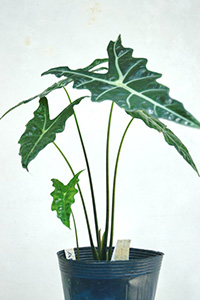 Alocasia, also known as ‘elephant’s ear,’ has recently gained popularity among ‘plant parents’ since the start of the community quarantine. This trend, which was coined as ‘plantdemic,’ has created opportunities for plant growers as the demand for Alocasia, as well as other ornamental plants, increased.
Alocasia, also known as ‘elephant’s ear,’ has recently gained popularity among ‘plant parents’ since the start of the community quarantine. This trend, which was coined as ‘plantdemic,’ has created opportunities for plant growers as the demand for Alocasia, as well as other ornamental plants, increased.
However, Alocasia’s demand in the market poses a threat to its species diversity; hence, the need for immediate action to conserve the said species.
The Philippine Council for Agriculture, Aquatic and Natural Resources Research and Development (PCAARRD) collaborated with the Philippine Nuclear Research Institute (PNRI), both agencies are under from the Department of Science and Technology (DOST), and partnered with De La Salle University - Dasmariñas (DLSU-D) Campus in the breeding of Alocasia through gamma irradiation and chemical treatments.
The project, which conducted a radiosensitivity study on Alocasia species, specifically A. maquilingensis Merr., showed that lower doses of gamma rays has improved its growth rate performance in terms of root structure while higher doses of gamma rays resulted in delayed seedling growth.
This indicates that subjecting the plant to lower gamma rays can break dormancy and enhance the germination of Alocasia’s immature seeds. Irradiated species of Alocasia are regularly monitored to observe possible mutations. To date, the project has observed initial plant mutations such as leaf cupping, leaf deformities, and double leaf.
Alocasia plants that will show promising mutated characteristics will then be developed into new varieties for registration and commercial production.
Another process that the project has done is karyotyping of Alocasia species. Under this method, chromosomes of irradiated samples are examined to identify possible genetic problems as well as plant disease. Karyotyping of Alocasia is currently underway to further investigate the morphological and chromosomal characteristics of the irradiated species to observe a favorable trait after undergoing irradiation process.
Furthermore, PNRI and DLSU-D was able to gather 27 accessions of Alocasia across the country consisting of 12 native species, two introduced species, and two hybrids. Among these, only six species were used for this study due to their abundance and propagation speed.
These recent developments and exploration in breeding of ornamentals present a way to save Alocasia and create better varieties of the said ornamental plant.
This project, funded by DOST-PCAARRD, will be featured in this year’s National Science and Technology Week (NSTW) 2020 through virtual exhibits and technology forum. Like and visit our Facebook page, https://www.facebook.com/PCAARRD/ to get updates about PCAARRD’s virtual exhibits and technology forum.
